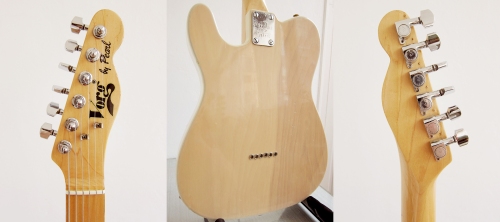Harmony H-162

Harmony H-162, Made in Chicago, USA in the late 1960’s
I finally put the second Harmony H-162 back together. I got two late 1960’s Harmony H-162 acoustic guitars about 2-3 years ago and it has taken forever to actually find the time to re-set the necks on them. The first one I put together back in November and that one was sold straight away. This one is reserved for a friend of mine but if he decides to get one of my Levin guitars instead then I will put it up for sale. They are really nice these Harmony guitars, wide neck, strong tone and great wood. Harmony used the same wood supplier as Martin back in the day. These were called folk guitars which is a grand concert size, the exact same size as a Martin 000. The Harmony H-162 was produced in Chicago from 1940-1971, this one is most likely from the late 1960’s looking at the headstock. Even though it was an inexpensive guitar at the time they were built with all solid woods, back and sides of selected quality mahogany with a resonant spruce top. It’s a surprisingly well sounding guitar for being a mass produced ladder braced guitar, way better sounding than any Gibson B-15 or B-25 I’ve heard and it cost a third. The neck is pretty wide which makes it extremely comfortable for finger picking. Considering the price of a late 1960’s Martin 000-18, or even a Gibson B-25, the Harmony H-162 is a bargain for a USA made all solid wood vintage guitar.

 The Harmony H-162 was missing machine heads, nut and saddle so I cut new ones in bone and added machine heads and some ebony bridge pins.
The Harmony H-162 was missing machine heads, nut and saddle so I cut new ones in bone and added machine heads and some ebony bridge pins.



 Fender Telecaster, Made in USA at the Fullerton plant in 1978-79
Fender Telecaster, Made in USA at the Fullerton plant in 1978-79

 A Fullerton built Fender Telecaster from 1978-79. Body and headstock shows 1978, pots and neck stamp shows mid-1979.
A Fullerton built Fender Telecaster from 1978-79. Body and headstock shows 1978, pots and neck stamp shows mid-1979. The three late 1970’s Fender Telecasters together,
The three late 1970’s Fender Telecasters together,  Harmony H-162, Made in Chicago, USA in the late 1960’s
Harmony H-162, Made in Chicago, USA in the late 1960’s








 I filled all the dents on the back of the neck with Nitro lacquer so now you can’t feel them when you play. The volume pot has been changed at some point and the knobs are not the same as on the other two S8 Telecasters. The frets are quite low and I need to replace the first five since they are pretty worn but she plays fine as it is. Except for that, it’s all original and sounds amazing. If I had space for them, I would have kept all three.
I filled all the dents on the back of the neck with Nitro lacquer so now you can’t feel them when you play. The volume pot has been changed at some point and the knobs are not the same as on the other two S8 Telecasters. The frets are quite low and I need to replace the first five since they are pretty worn but she plays fine as it is. Except for that, it’s all original and sounds amazing. If I had space for them, I would have kept all three.










